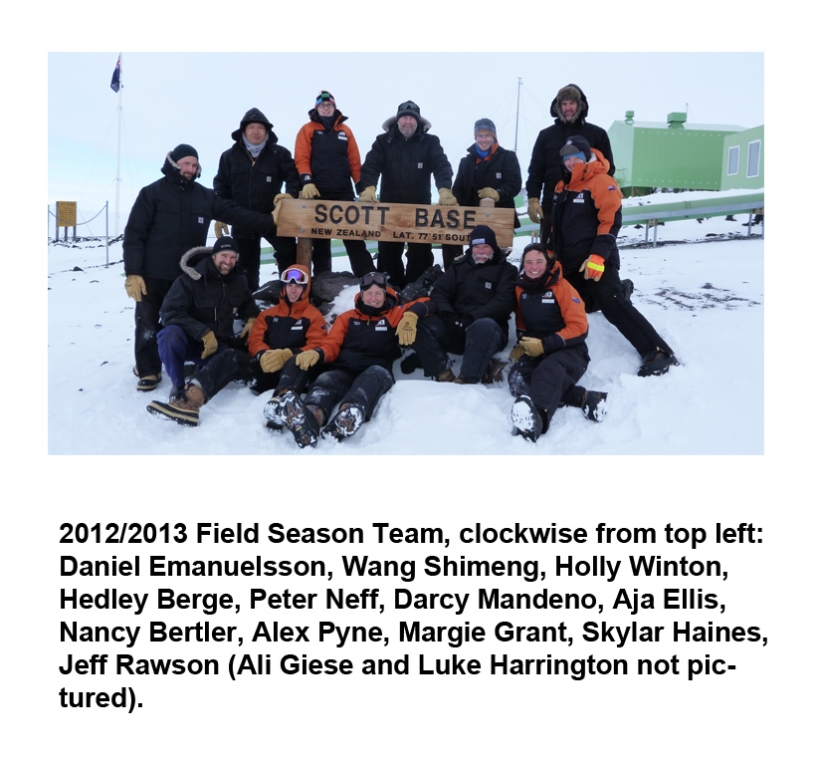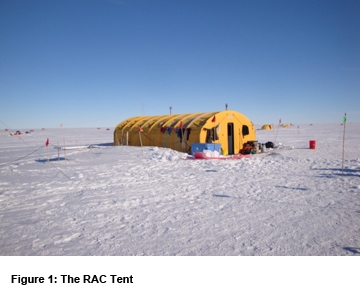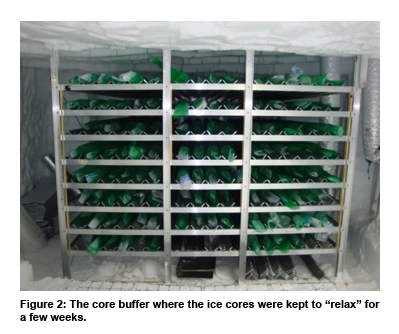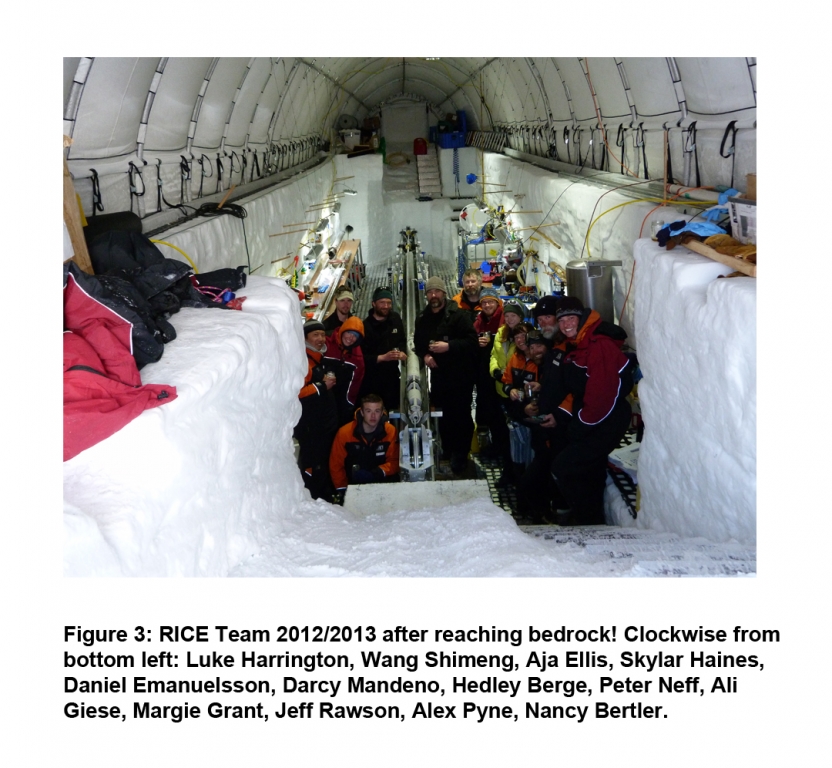Roosevelt Island Climate Evolution (RICE)
Roosevelt Island Climate Evolution (RICE)
Introduction
RICE is an international collaboration between New Zealand, USA, Denmark, United Kingdom, Germany, Australia, Italy, China, and Sweden. The aim of the project is to recover a 750 m deep ice core from Roosevelt Island in Antarctica to determine the stability of the Ross Ice Shelf and West Antarctica in a warming world (Dr. Nancy Bertler Victoria University Wellington (NZ) and Climate Change Institute, University of Maine, Chief Scientist).
For details please go to: Victoria University of Wellington’s RICE webpage: http://www.victoria.ac.nz/antarctic/research/research-prog/rice/
Scientific Background
The potential for rapid deglaciation of West Antarctica remains a primary uncertainty in the Intergovernmental Panel on Climate Change (IPCC) predictions for 21st Century sea level rise and of course the climate science community. The recent and unpredicted collapse of multiple ice shelves and rapid acceleration of discharge of Antarctic ice suggests that dynamic responses to warming play a more significant role than is currently understood and captured in coupled climate-ice sheet models. Such models can be improved and validated by replicating known past changes. The RICE Project is an international partnership seeking to understand past, present, and future changes of the Ross Ice Shelf, a major drainage pathway of the West Antarctic Ice Sheet. The ANDRILL program showed, that about 5 to 3 million years ago, the last time when atmospheric carbon dioxide (CO2) concentration and temperatures were similar to those predicted for the end of the 21st Century, the Ross Ice Shelf disintegrated multiple times, initiating the collapse of West Antarctica. However, no high-resolution data exist from this time period. To determine the rate of change, RICE aims to provide an annually resolved ice core record for the past 20,000 years and beyond, when global temperatures increased by 6 deg C to preindustrial temperatures, global sea level rose by ~120 m, and the Ross Ice Shelf grounding line retreated over 1,000 km. Most of the Ross Ice Shelf retreat occurred when global sea level had already reached modern levels. For this reason, the precise correlation between increasing air and ocean temperatures, and the velocity and characteristics of the ice shelf retreat, provides a unique opportunity to determine accurately the sensitivity of the Ross Ice Shelf to warming (Bertler, pers. Comm. 2012).
Field Season 2012-2013
As my first field season as a student at the Climate Change Institute, I worked as an ice core processor under the direction of Dr. Nancy Bertler with fellow core processors Daniel Emanuelsson, Aja Ellis, and Holly Winton.
Before we could resume drilling operations from the previous season, it was necessary that we set camp back up into working order. By the time I had arrived out in the field, November 5, 2012, the RAC tent had already been set up for use. The RAC tent is a modular shelter system, and it was our only heated environment. It housed a kitchen for our excellent cook, Margie Grant, a shower to be used sparingly, and enough room to get the team together for meals and leisure (fig. 1).
The next few weeks, I assisted the team with such tasks as digging a pit to serve as food storage for the season, enlarging the ice core freezer in the drill tent, constructing an insulating curtain that would help keep the ice cores as cold as possible in the freezer, and organization of the camp in general. I also began to take daily snow surface samples to be processed in conjunction with the ice core, in order to better discern the chemical signals to be analyzed. Once camp was set up, and the drill had been assembled, we were ready to resume drilling from the previous season.
This season we were “wet drilling,” as opposed to the “dry drilling” that was done during last year’s field season. We call it wet because while drilling the ice core, we had to deal with the drilling fluid that was put in the borehole last season to keep it from collapsing in on itself over the winter season. The drilling fluid we used was a mixture of the chemicals estisol and coasal. The fluid has special physical properties that were ideal for ice core drilling in our environment, such as a similar density to ice, a very low freezing point, non-toxic, and a lesser impact on the environment than other drilling fluids. We wore special suits to limit our exposure to the fluid. As we drilled farther, we poured more fluid into the borehole, roughly to the height of the bottom of the casing that was installed in the top 60 meters of the borehole. The casing maintained the integrity of the borehole near the surface, keeping the firn from collapsing into the hole.
Last year, the team drilled the first 130 meters of the ice core. This season, the goal was to drill all the way down to the bedrock, which was estimated to be around 750 meters deep. In order to maximize efficiency during the drilling process, the team split up into two shifts, a day shift and a “night” shift. Each shift would work ten hours a day, so we were effectively working around the clock to ensure a timely finish of the project. I was a core processor on the night shift, along with core processor Daniel Emanuelsson and drillers Darcy Mandeno and Wang Shimeng.
Each shift had two drilling members and two core processors. The primary driller would maintain control of the drill, to make sure that it was drilling smoothly with no problems. Once the core was drilled to depth, around 2 meters in our drill’s case, the driller would perform a core break with the hydraulics of the drill system to nicely break the core. This was a special moment during the process because it required help from a core processor to supervise the winch brake, for there was a large amount of force pulling on the winch system. The winch then pulled up the drill, containing the ice core. The drillers would then detach the inner core barrel from the outer core barrel. The ice core, inside the inner barrel, would then be transferred to the core processing side of the drill tent. There the core would be pushed out of its barrel, through a vacuum to clean the core of drilling fluid, and onto an aluminum tray to be processed.
The processing of the ice core involved measuring the length of the core to ensure the correct depth for the drillers next run, orientating the ice core with the previous drilling run, marking the core to be cut into one meter pieces, taking temperature and ECM (Electrical Conductivity Measurement) readings, cutting the core, and bagging it to be stored in boxes that would go in the freezer, ready for transport.
As we drilled deeper into the ice, the ice became progressively more brittle. This was because the ice at such depth is under a much greater pressure regime, and exposing that old ice to the surface, where pressures are much less, the ice has a tendency to expand, and sometimes crack. We were very careful in handling the ice cores at this stage. We modified our processing of the ice cores to ensure the cores would be put to rest in the best possible condition. We began using a green mesh sleeve once the ice got very brittle, so that if a break were to occur, the ice core would be contained in the sleeve, still in its original orientation and configuration. We also allowed the ice cores to “relax” and become less brittle in the core buffer (fig. 2) for a few weeks before processing.
The team began drilling on November 21, 2012, and we reached bedrock exactly a month later on December 21! The final drilling depth is 763 meters. It was fascinating to see the change of properties in the ice during the entire process. From becoming more brittle due to the increase in pressure at depth, to slightly warmer ice from geothermal heat, and finally to seeing small pieces of rock sediment inside the light brown colored ice before hitting bedrock. The drill bit had a small amount of sediment on it, which will be of great interest to some, in addition to the ice!
After the drilling was finished, we began the process of decommissioning the camp and preparing cargo that would stay at camp to be wintered over. Aja Ellis, Luke Harrington, and I sampled a two-meter deep snow pit at one-centimeter resolution so that we would have high resolution data to contribute to the ice core data.
For a further look at the RICE project, see the webpage by Thomas Beers from last years field season: http://climatechange.umaine.edu/roosevelt_island_climate_evolution_rice
Please read the blog by Dr. Nancy Bertler for an account of the progress for the 2012/2013 Field Season: http://www.victoria.ac.nz/antarctic/research/research-prog/rice/field-season- blogs






